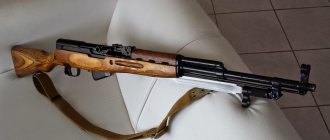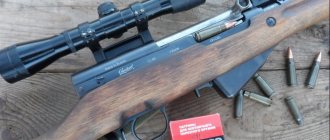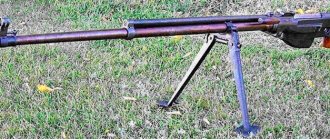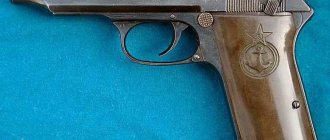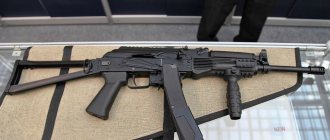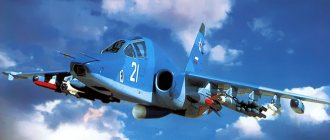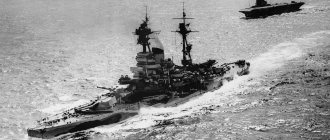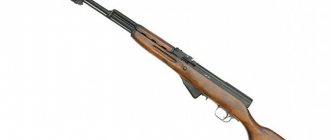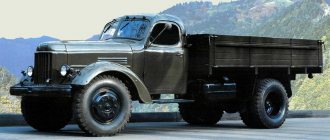Home | Weapons | Self-loading rifles | Russia / USSR | Simonov SKS self-loading carbine
Original Soviet-made Simonov SKS self-loading carbine
Simonov SKS self-loading carbine with bayonet in firing position
Tuning SKS in the style of the American Colt M4A1 SOPMOD M4 carbine
The 7.62-mm Simonov self-loading carbine (SKS, GRAU Index - 56-A-231, also known abroad as SKS-45) is a Soviet self-loading carbine designed by Sergei Simonov, adopted for service in 1949. After the adoption of the 7.62×39 mm intermediate cartridge designed by N.M. into service in 1943. Elizarova and B.V. Semin, work began to create a new small arms system chambered for this cartridge.
The first samples of the SKS chambered for 7.62x39 mm were created by Simonov towards the end of 1944 on the basis of a carbine that he had developed as part of a competition for a new carbine back in 1940-1941, but which did not go into production due to the evacuation of factories. In addition to the cartridge, the features of the new self-loading carbine are a permanently folding bayonet, the absence of a muzzle brake-compensator, and a removable gas chamber. A small batch of new Simonov self-loading carbines was tested in active units of the 1st Belorussian Front at the beginning of 1945, and was also supplied to the Vystrel courses. The weapon received positive reviews, but development of the carbine and the new cartridge continued until 1949, when the SKS entered service with the Soviet Army.
For a decade, the SKS was in service with the army along with the Kalashnikov assault rifle and the Degtyarev light machine gun. All three samples for the intermediate cartridge significantly complemented each other and had certain advantages and disadvantages. For example, the AK, due to the ability to fire in bursts, created a greater density of fire, which increased the effectiveness of shooting at short distances, as well as when firing at group targets. At the same time, the sighting line and barrel of the Simonov self-loading carbine are 10 and 10.5 cm longer, respectively, than that of the AK, which has a positive effect on accuracy. Due to the automation of loading and the ability to replenish the magazine using a clip, the SKS satisfied all the requirements for conducting fire combat at medium and long distances.
By the end of the 50s, in order to unify small arms in the Soviet Army, a decision was made to universally replace carbines in rifle units with machine guns. According to the command, along with the undoubted advantage of the AK in the high density of fire from rifle units, the advantage of the SKS in conducting single fire can be neglected, since in modern combat the latter factor no longer played a decisive role.
However, until the end of the 80s, the Simonov self-loading carbine was in service with a number of engineering, military construction, and support units, where fire combat was not the main task. Currently, the SKS is in service with the paramilitary guards (VOKhR), and also, due to its aesthetic qualities, is used as a ceremonial weapon.
The SKS was also supplied to many countries in Asia and Africa and was widely used in armed conflicts of the 50-70s, including the Korean and Vietnam Wars. The Soviet or Chinese-made Simonov self-loading carbine was supplied to the most combat-ready units of the Viet Cong, and during the fighting it was revealed that the SCS met the requirements of jungle warfare. In fact, the carbine even had excess firepower, since clashes with the American military took place at distances much shorter than the effective firing range of the SKS. A higher rate of fire of the weapon was also noted compared to conventional repeating rifles, which played an important role in fast-paced battles.
As often happened with samples of Soviet weapons, the production of licensed copies of the carbine was established in friendly countries: Type 56 (PRC), Karabiner-S (GDR), Type 59 and Type 59/66 (Yugoslav variants with a muzzle attachment and a folding sight for firing rifle grenades), “Rashid” (Egyptian version with a modified design of the receiver lining, receiver cover and a different location of the reloading handle) and other options. In total, taking into account domestic and foreign enterprises, more than 15,000,000 copies were produced. In the modern world, the SKS is a popular example of civilian weapons (largely due to its low cost, unpretentiousness and reliability), so up to 2.5 million carbines were sold in the USA, and a wide range of American-made accessories are also on sale (folding stocks, optical sights, detachable stores and much more).
Design
The Simonov self-loading carbine consists of the following parts and mechanisms:
- barrel with receiver, bayonet and sights,
- receiver cover;
- gate;
- return mechanism;
- gas tube with receiver lining;
- gas piston;
- pusher with spring;
- trigger mechanism;
- shop;
- box.
A clip is used to quickly fill the integral 10-round magazine. To use the clip, there are special guides on the bolt frame. When the cartridges are used up, when the magazine is empty, after the last shot, the bolt goes into a slide stop, which reduces the time for subsequent replenishment of the magazine with cartridges.
SKS sights consist of a sight and a front sight. The sight, in turn, consists of a sight block with a leaf spring, an aiming bar and a clamp with latches and springs. The sight block has two sectors to give the aiming bar a certain height. On the bar there is a scale with divisions from 1 to 10 (indicating the firing range in hundreds of meters) and the letter “P” (permanent sight setting, corresponding to sight 3).
The bayonet is a bladed, permanently folding one, consisting of a blade with a base and a tube with a spring (providing shock absorption of the bayonet for uniform SKS combat, regardless of the position of the bayonet). Some early Simonov self-loading carbines had a needle bayonet.
The SKS kit includes: accessories (cleaning rod, cleaning rod, brush, drift, pencil case and oil can), belt, cartridge bags and clips.
Reloading of the SKS after the next shot is carried out automatically, for which the energy of the powder gases removed from the barrel is used. The barrel bore is locked by tilting the bolt downwards. The barrel is black forged, not chrome plated.
Hunting use
Great power, reliability and rate of fire, and other technical characteristics of the SKS carbine have made it possible to widely use the SKS as a weapon for commercial hunters. Large stocks of carbines in warehouses caused this model to appear on sale after a little tuning.
Tuning the SKS carbine has become a fairly common service among amateurs and professional hunters. First of all, work is carried out, and such characteristics of the SKS as combat accuracy are improved. At the same time, modifications are made to the barrel and trigger mechanism to ensure a smooth descent. Convenience of using SCS while hunting is achieved by using ergonomically comfortable stocks and stocks made of various types of wood and plastic.
Hunting with an SKS carbine requires secrecy and invisibility of the shooter, therefore the SKS hunting carbine is equipped with a muzzle brake and a flash suppressor. Shooting at long distances also requires the installation of an optical sight with a reliable quick-release mount on the Simonov carbine. Optics for SCS are represented by various types of collimator and optical sights of various zoom ratios.
A small piece of brightly colored insulation on the front sight, or the application of luminescent paint in this area will allow you to aim even in twilight conditions.
Automation operating principle
At the moment of firing, when the bullet passes through the barrel, powder gases under high pressure rush through a special hole in the barrel wall into the gas chamber, where they set in motion the gas piston, the pusher, and with it the bolt. The bolt, in turn, opens the barrel, compresses the return spring and cocks the hammer. In this case, the cartridge case is removed from the chamber and thrown out.
Next, the bolt, under the action of the return mechanism, returns forward, sending a new cartridge into the chamber and closing the barrel bore. The side face of the bolt frame rests against the combat stop, and the locking protrusion of the bolt stem holds the bolt frame in this position. After this, to fire, you must release the trigger and press it again.
When the last cartridge is fired, the bolt will rest on the bolt frame and will not move further, which will be a signal to the shooter about the need to reload.
↑ SKS as a hunting carbine
In Soviet times, the SKS was a pipe dream for the amateur hunter. If you have a choice between SVT-40, SKS and Mosin carbine mod. 1944, preference was usually given to the SKS. A lightweight, reliable and unpretentious self-loading carbine, with a fairly powerful cartridge and acceptable accuracy, was the favorite weapon of several generations of Soviet researchers, forest guards and commercial hunters.
Created for use in conditions of trench mud and hand-to-hand combat, the Simonov carbine turned out to be a wonderful hunting weapon in the wild Siberian taiga and the Far North. The 7.62x39 live cartridge bullet, optimal for incapacitating a person weighing up to 100 kg, turned out to be “weak” for large ungulates and bears. The appearance of hunting versions of the cartridge has somewhat improved its effectiveness, but the stopping effect is still clearly lacking. Accurate shooting “on the spot” helps, which is something many SKS owners lack. Fans of powerful large-caliber rifles who are confident in the ability of a heavy 9-mm bullet to kill any animal in place can cite as an example the facts of the systematic successful shooting of African elephants from 7-mm rifles (when shooting in the “right” place, of course) and cases of bears ignoring bullets .416 Rigby, when hit in the intestines and other non-lethal areas.
Now the Russian hunting society is discussing the new law “On Hunting”, where the 7.62x39 cartridge has practically been removed from the list of cartridges permitted for use in hunting in Russia. One can argue for a long time about the effectiveness and rationality of using the mod cartridge. 43 years of hunting, you can cite convincing numbers and argue with intricate terms from the field of external and wound ballistics, talk about joules, kinetics and damaging properties of various bullets. And draw categorical conclusions about the unsuitability of the intermediate cartridge and weapons for it for hunting animals in general and in particular.
Or you can hit the spine, the head, offhand with the first shot, break the heart and parenchymal organs of the animal with a half-sheathed bullet, laying down large bears and moose in place. Of course, it doesn’t happen every once in a while, sometimes a boar with a broken heart, a broken 12-gauge Brenneke Magnum and broken lungs into dust walks about a hundred meters up the mountain and rushes at the hunter. Once upon a time, working in emergency surgery, I sometimes observed how long a person who had been shot from a TT and lost a huge amount of blood could live - the really vital organs were simply not seriously affected. My uncle, when he was a national park ranger, in the 90s. was vilely, at point-blank range, shot by poachers using a sawn-off shotgun with large shot. The whole chest was like a sieve. But he managed to destroy the poachers and crawl several kilometers towards people. And he survived after a very difficult operation. And at the same time, I saw people dying from being wounded by a bullet from a small gun.
This is all to say that the art of truly virtuoso hunting is the ability to hit not even “in the right place,” but to get to that point of the notorious “place” when the animal lies down in place, even when hit by a bullet from a live cartridge from an SKS. After all, no one will argue that a good cattle slaughterer hits not “on the spot”, but “on the spot” like a jeweler? If I had not witnessed fantastic shots from the SKS, and not random, but systemic, then, probably, I would have foamed at the mouth in defending the need to ban all ammunition with a caliber of less than 9.3x54.
But I also see something else - how hunters go into the forest, who have never shot at clay pigeons on a stand, who have not heard of the “running boar” target, who do not know the equipment of the weapon and the conceptual principles of handling it. And when a wild boar or elk “stitched” through its guts goes kilometers away and then dies in the thickets, then why blame the SKS if you don’t know how to shoot? Probably, the caliber of a rifle is not as important as the ability to correctly determine the distance and time of a shot, combined with the ability to shoot quickly and accurately.
The other side of the professional approach is to shoot as quickly as possible, literally “filling” the animal with bullets (as one of my friends says: “I don’t shoot very accurately, but very quickly”). The method is effective and time-tested, perfect for SCS. “Defenders of nature” and other armchair “humanists” who do not know the life of fishermen and other “black people” can keep their emotions on this matter to themselves.
The SKS is an excellent rifle for shooting wolves, hunting any small ungulates, pigs, and any animals weighing up to hundreds of kg. Thanks to the excellent weight distribution, the carbine seems very light and fits perfectly when shooting offhand. The accuracy of the SKS is absolutely sufficient for hunting tasks solved by the bullet of its cartridge. When installing optics, the SKS can be used up to 300 m (an undamaged carbine at 100 m with expansive Klimov cartridges produces groups of about 6-7 cm when fired from an open sight), although in reality the effectiveness is limited to 150-200 m.
Disassembly, assembly and maintenance
Partial disassembly of the SCS is carried out for cleaning, lubrication and inspection in the following order:
- removing the pencil case with accessories from the butt;
- cleaning rod compartment;
- separation of the receiver cover;
- removing the return mechanism;
- removing the shutter;
- separation of the frame from the bolt stem;
- separation of the gas tube with the barrel lining.
Reassembly after partial disassembly is carried out in the reverse order.
Complete disassembly of the Simonov self-loading carbine is carried out for cleaning in case of heavy contamination, after exposure to rain or snow, when switching to a new lubricant and repair in the following order:
- incomplete disassembly;
- removing the pusher with the spring;
- firing mechanism compartment;
- store branch;
- separation of the barrel with the receiver from the stock;
- disassembling the trigger mechanism;
- disassembling the return mechanism;
- separation of the firing pin and ejector from the bolt body.
Reassembly after complete disassembly is carried out in the reverse order.
It is recommended to use gun lubricant and alkaline composition (to remove powder deposits) in summer (at temperatures above 5 °C), and in winter (from +5 °C to −50 °C) to use liquid gun lubricant (for lubrication and removal of deposits) , carefully removing (by washing all metal parts in kerosene or liquid gun lubricant, thoroughly wiping with a rag or tow, then rinsing again and wiping with a clean rag) before doing this the summer lubricant. For long-term storage, the carbine is generously lubricated with a mixture of 50% gun lube and 50% gun lube by dipping the cleaned metal parts twice into baths of hot lube.
Ammo
Shooting from the SKS is carried out with cartridges of the 1943 model (7.62×39 mm) with the following types of bullets:
- an ordinary one with a steel core is designed to defeat enemy personnel located openly or behind obstacles pierced by a bullet. The shell is steel clad with tombac, the core is steel, and there is a lead jacket between the shell and the core. Has no distinctive coloring.
- The tracer is designed for target designation and fire adjustment at distances of up to 800 m, as well as defeating enemy personnel. The core consists of an alloy of lead and antimony, behind which there is a cup with a pressed tracer compound. The color of the head part is green.
- armor-piercing incendiary is designed to ignite flammable liquids and destroy manpower located behind lightly armored shelters at ranges of up to 300 m. The shell is with a tombak tip, the core is steel with a lead jacket. Behind the core in a lead pan there is an incendiary composition. The color of the head part is black with a red belt.
- the incendiary is designed to ignite flammable liquids in iron tanks up to 3 mm thick, flammable materials at ranges up to 700 m and target designation at distances up to 700 m. The incendiary composition is located between the shell (with a tombak tip) and the steel core, the jacket is steel. Behind the core and jacket there is a cup with a tracer compound. The color of the head part is red.
Options
Based on the Simonov self-loading carbine, hunting and fishing carbines were developed:
OP-SKS (hunting-commercial) - SKS, converted at the Tula Arms Factory from a military weapon to a hunting weapon by removing the bayonet lug, filing the aiming bar up to 300 meters and adding a pin to the barrel (according to the Law “On Weapons”). Otherwise, SKS and OP-SKS are completely the same.
TO3-97 “Arhar” is a variant developed at the Tula Arms Plant and differs from the SKS in the mount for the PO-4x34 optical sight and a modified wooden or plastic stock, more suitable for hunting. The sighting bar is limited to 300 meters, there is a pin in the barrel.
KO SKS (hunting carbine) is a variant of TsKIB SOO.
NPO Fort produces two modifications: SKS-MF (Soviet SKS carbines without a bayonet) and Fort-207 (Soviet SKS carbines with a new forearm and butt made of black plastic)
These carbines are very popular among commercial hunters due to their low price, ease of maintenance, unpretentiousness and reliability. The carbine operates reliably at temperatures from −50 to +50 degrees Celsius (an indicator of the high reliability of the SKS is the fact that this particular carbine was taken with them by the participants of the Transarctic 2006 expedition for protection from polar bears). It is generally accepted that these SKS variants are mainly used for shooting fast and relatively small animals such as wolves or foxes, since the 7.62x39 mm cartridge does not effectively hit large game. At the same time, it is necessary to take into account that the common opinion about the insufficient effectiveness of the 7.62x39 cartridge in traditional Russian hunting can only be substantiated by comparing this caliber with a obviously more powerful one (for example, 7.62x54 mm R). The weak stopping effect of a standard military cartridge bullet (and not the low efficiency of the cartridge as a whole, as is commonly believed), coupled with the inability to shoot, is the main reason for all sorts of stories about moose and wild boars with dozens of wounds. The problem is solved by using hunting ammunition with semi-jacketed or hollow-point bullets in hunting, which have a sufficient stopping effect when hitting a medium-sized animal (wolf, wild boar, deer, bear, roe deer) and ensure a confident defeat of game.
Considering the huge number of SKS that is currently in warehouses, in the Russian Federation, Ukraine, Belarus and other republics of the former Soviet Union there are a number of enterprises that are engaged in converting SKS carbines into OP-SKS and Arhar, after which the carbines are already in civilian option are supplied to the retail chain.
MAKSIMOV.SU
In March 2016, in the magazine "MR" I already wrote about tuning the SKS .
Then we touched on the main issues related to improving the accuracy of the carbine, as well as improving ergonomics, additional attachments and much more. It would seem - well, what else can you come up with for this carbine, which today’s hunters and rangers do not like?
Modified
SKS-45
As it turned out,
the number of components for upgrading SCS on the Russian market is only increasing.
Quality is also growing, and it is domestic manufacturers who are most actively “raising the bar”. Contrary to all forecasts, sales of SKS carbines are consistently good, both in the native 7.62x39 mm caliber and in the increasingly popular .366 TKM cartridge. In this article
we will look at some of the new products for improving the SCS: from “sports” USMs and replaceable 30-place magazines to various DTKs.
If you wish,
a lot of interesting goodies on SKS
"Store" question
or how to make an SKS 30-round carbine
In Russia
hunting is allowed with weapons with a magazine of 10 rounds, no more. For collective hunting, the magazine capacity of a multi-shot weapon is limited to 5 rounds. For sport shooting, the use of large-capacity magazines is allowed. There is a demand for such products. Previously, it was satisfied through imported supplies, but now our manufacturers have joined in.
In that
two companies operate in Russia. They followed the path of foreign companies Tapco and ProMag, which produce removable magazines for SCS of various capacities. In our country, polymer magazines for Simonov are produced with a capacity of 5, 10, 20 and 30 rounds.
30-seat magazines for SCS
manufactured by PUFGUN
This
gave the market affordable stores (at a price of about 800 rubles versus 3.5-4 thousand rubles for imports) and practically ousted similar foreign products from the market.
Justice
For the sake of it, I note that our manufacturers of high-capacity interchangeable magazines for SCS did not reinvent the wheel, but practically copied well-proven products. At the same time, the Chinese comrades were doing the same thing, offering “nosy stores” at a price cheaper than the “company”, but more expensive than Russian products.
So
Thus, the stores are already known to my readers
, and we will talk about them, found themselves in the most profitable niche.
A 30-seat magazine
manufactured by PUFGUN
offers a line of stores under the general name Mag SKS762, which is available in six colors. A magazine in any color can be shortened with a regular hacksaw to the desired length, and it is also possible to buy a version of the required capacity.
All
SKS carbines have some differences, both due to manufacturing tolerances and due to repair work before storing weapons in long-term storage warehouses in the 1960-1970s. Therefore, PUFGUN magazines are made with a small allowance, which requires minor modification before use.
In my
In this case, it was necessary to refine the mating unit with the locking mechanism and the bolt stop using a file. I did it in 5 minutes, there is nothing complicated here, besides, the manufacturer on its website offers detailed instructions for individually adapting magazines to weapons.
Shooting from an SKS with a detachable PUFGUN magazine
Working
PUFGUN stores without any complaints. Statistically, their reliability is no worse than a regular store. The only disadvantage of this design is the bulkiness associated with the presence of a “beak” in the upper front part of the magazine.
Aesthetically
multi-charge magazines on SKS look worse than standard ones, but this is a matter of taste and need. And with a polymer stock and a 30-seat horn, the old SKS turns into a completely modern weapon. Which, importantly, can be returned to its original state in just a few minutes.
30-seat PUFGUN and USM store attached to the SKS , modernized by Roman Efimov
SKS for driven hunting
or how to make a standard magazine 5-round
In this case
we have the opposite problem - the need to limit the capacity of the SKS magazine to five cartridges, in accordance with the current requirements of driven hunting. Here you can get by with using the shortest PUFGUN magazine, but not all aesthetically minded hunters agree with this decision.
Can
mechanically limit the capacity of a standard magazine, but not all huntsmen perceive this decision well. All that remains is to make or purchase a compact magazine for the SKS with 5 rounds. Moreover, such a store can even be detachable.
The standard SKS magazine
can only be opened to remove unspent cartridges. It is impossible to remove it without removing the stock
Exactly
Such magazines are manufactured by Moscow hunter Alexey Froltsov. It all started out of passion, when in 2016 Alexey purchased a VPO-208, that is, an SKS chambered for 366 TKM. During the operation of the weapon, the idea came up to make a detachable magazine for 5 rounds, which would be more convenient and “more correct” for hunting without losing reliability.
Spoiled
several SKS magazines, Alexey literally “on his knees” launched into a small series the MOsB-5 model - a detachable magazine with a lock for 5 rounds.
MOU-5 magazine (right) for 5 rounds
designed by Alexey Froltsov in comparison with the standard SKS magazine
Capacity
The store was important, since Alexey was going to use his VPO-208 on collective hunts. Having made such a store and shared the essence of its advantages with like-minded people on the Internet, the master began to receive letters from SCS owners asking him to make such a store for them.
Further
hunters expressed a desire to receive a shorter, more aesthetic version of the magazine. This is how a shortened version was born, which was called MOU-5 (a detachable magazine shortened for 5 rounds). Although there is no mention of a blocker in its name, it is present there.
Alexei
manufactures different versions of magazines: integral with a hemp stopper for 5 places, integral shortened for 5 places, detachable for 10 places with the possibility of connecting only with a retracted bolt, MOsB-5 and MOU-5. There is also a variant MOsB-5M. This magazine has a standard size and differs from MOsB-5 only in the location of the blocker.
MOU-5 magazine on SKS, side view
SKS Lodges
may have some differences in size, so the standard arrangement of the blocker precludes its use. Of the entire model range, Alexey honestly considers only stores with blockers to be his brainchild, because... all other options were known earlier.
Alexey Froltsov
with the participation of Sergei Martynov, the “Conductor .366 FM” product was also developed and manufactured, which is designed to improve the expansion of bullets in the .366 TKM caliber. Based on the developments of Froltsov and Martynov and their tests of bullets in the named caliber, the Kion bullet was launched into production.
Also
Alexey and Sergey developed and implemented several types of DTK for new smoothbore shotguns in calibers .366 TKM and 9.6/53 Lancaster.
MOU-5 magazine on SKS,
bottom view
Sports USM
for SCS
SCS
has always been “famous” for its descent: long, uneven, tough, frankly difficult and unpredictable. The reason is the design of this unit: the trigger of the carbine is made according to a scheme with a break in the kinematic connection between the trigger and the sear, which ensures firing of single shots. The sear moves progressively.
Features of the USM
carbine SKS
Wherein
To fix the magazine cover and operate the sear, the same cylindrical spring is used. If it is loosened, unauthorized opening of the magazine cover may occur during shooting, which leads to cartridges spilling out. That is, this step, logical at first glance, is not applicable in our case.
Bring USM
It is almost impossible to polish an SKS carbine to the desired condition using traditional polishing, sharpening and lubrication, although this is also an important and necessary point.
It is necessary, at a minimum, to isolate the fixation of the magazine cover from the impact on the sear. This is a difficult task. And the Moscow gunsmith Roman Efimov handled it brilliantly. Disassembling the SKS-45
To
To eliminate excessive force on the trigger, Roman replaced the sear spring with a weaker one. At the same time, the reliability and safety level of weapons remained at the standard level. But for this purpose, a steel tube with a spring-loaded magazine box clamp was welded to the lower part of the trigger block. This is an independent and completely harmonious element, the task of which is to securely close the magazine lid.
Further
Using a screw and an adjusting nut, the failure of the trigger was eliminated. If you have a welding machine, you can get by by welding a limiter, which is adjusted by filing.
Standard SKS trigger (bottom) and trigger,
modernized by Roman Efimov
Standard SKS trigger (bottom) and trigger,
modernized by Roman Efimov
Next operation -
restriction of trigger free play. This can be done in two ways: increasing and grinding in the thrust acting on the sear or reducing the front part of the window for the trigger. Due to changes in the travel angles of the trigger, the fuse needs to be adjusted, which, by the way, can be made double-sided.
After
With this modification we get a softer and shorter trigger overall travel of the trigger.
According to personal feelings, the characteristics of the modified SKS trigger are close to the basic parameters of the trigger of modern bolt-action rifles. In the case of correctly laid hardware, a normal barrel and a more or less decent cartridge, a modified trigger can significantly improve the accuracy of the SKS engagement. At the same time, the reliability of the weapon does not suffer, and we also do not have any constructive interventions in the main parts. USM designed by Roman Efimov on SCS, right and left views
Brackets
for optics on SKS
Here
the situation is still sad: apart from the appearance of a variety of clones of V. Rassolov’s bracket in place of the standard sighting bar, there is nothing sensible. If for collimators this is still all right, then installing a full-fledged optical sight on an SKS is still a big problem today (unless you have a carbine with a side rail from the Hammer).
Without a locksmith
no way, and all the “picatinny” options with fastening to a sector sight block and a transverse hole in the receiver are either structurally weak or extremely inconvenient to use.
Collimator sight "Pilad R1x20", mounted on a bracket in place of the standard SKS sighting bar
On photos
you see the “Zhuk” and “Zhuchok” Weaver/Picatinny base brackets instead of the standard sighting rail for SKS production. Like the prototype (Rassolov’s bracket), these products are designed for mounting red dot sights mounted on a weaver/picatinny rail. The differences in the design of the brackets lie in the size and height of the location on the weapon. Materials: B95 alloy and steel.
Installation
These brackets do not require the use of plumbing or special tools.
All you need is a drift, a hammer and a hex wrench. By the way, a file can also come in handy, but not in every case. I repeat that all SKS carbines are slightly different. Therefore, the steel bracket liners are made to the maximum tolerance limit. Collimator sights "Pilad R1x20" and PKU-2 Oil Refinery on SKS
For the most part
In some cases, the liner is installed snugly. My SKS turned out to be special, so I had to scrape the front end of the liner a couple of times with a velvet file.
Both brackets
Compact open and closed collimator sights “hold” without any problems. Aiming is more comfortable, shooting is faster (especially with DTK) and more effective.
Installation of a
picatinny rail for a collimator sight on an SKS carbine
One of the bracket options for SKS with a picatinny rail along the entire length of the receiver
Another
The bracket for SKS from the same manufacturer is a Weaver/Picatinny base called “Staff”. This design is attached at one end to the place of the standard sighting rail, the rear part is fixed to the receiver using a saddle clamp and a transverse screw. Installing the strap requires cutting off the locking pin of the receiver cover pin and removing the pin itself.
"Staff"
and similar designs allow you to install any optical and night sights on the SKS. Such a bracket requires metalwork, dismantling the entire structure to clean the weapon and, accordingly, re-shooting before hunting.
Bracket "Staff"
on SKS
DTK classic type
This time
I tried a product designed by Ruslan Rodionov. This is a combined (active-reactive) action muzzle device. To install the DTK on the SKS, a sliding fit and reliable fastening to the collet are used using two tightening screws and an additional element for fixing the front sight post.
This
a proven and justified solution to avoid the risk of the muzzle device falling off the barrel of a weapon.
DTK for SCS
designed by Ruslan Rodionov
DTK
made of quality steel. Processing without any complaints. The coating is thermal oxidation of a beautiful gray-blue color. The design of the product uses hardened clamping screws with a hex key. This model performed very well in operation.
Noted
a significant reduction in the recoil level, almost completely compensating for the weapon’s drift during rapid shooting.
The overall efficiency is at the level of the best products from other domestic manufacturers. What is important is that the price for DTK for SCS from this manufacturer is within 2.5 thousand rubles. DTK for SKS designed by Ruslan Rodionov, bottom and top views
Closed type DTK
We have repeatedly talked about
that no “can” will give you the “cinema” sound of a shot. It is simply impossible to silence a standard cartridge even with the help of PBS. But it is possible to remove the flash and change the sound of the shot to a comfortable one (for example, for shooting without headphones) using a closed-type DTK.
In Russia
Products of this kind are now produced by half a dozen companies. But only one manufacturer offers on the market gas-relieved closed-type DTKs, which reduce the sound of a shot by 26-28 dB and eliminate flash to a minimum. This is Rostov
, which specializes in tuning military and civilian weapons and supplies its products to the law enforcement agencies of the Russian Federation.
Fastening the closed-type DTK “Rotor 43” (with gas discharge) to the muzzle of the SKS barrel using a clamp
Exactly
this organization recently proved in court that its products are completely legal. This was an unprecedented case.
DTK from "Rotor-43"
is a 6-chamber non-separable cylinder with a seat in the form of a “bayonet tube”. The total length of the product is 160 mm, diameter is 44 mm. Material – steel St40X or titanium. The coating is black polymer. The weight of the steel version is 580 grams, the titanium DTK weighs only 400 grams. Guaranteed resource - 10 thousand shots.
DTK
It is attached to the SKS in the most optimal way for such a design - by the front sight post, on a powerful clamp. This ensures not only a rigid fit of the product on the muzzle of the weapon barrel, but also correct axial positioning of the device. Installing a steel DTK significantly affects the balance and weight distribution of the weapon.
For SCS, the use of a closed-type DTK
for hunting purposes is completely justified. This is world experience that it’s time to adopt
For shooting
handheld it takes some getting used to. Usually, when shooting with a “can,” the accuracy of the battle improves. In my case, with the Rotor DTK on the SKS, this is exactly what happened - the official 80-mm “heap” shrank to a stable 60-65 mm over 4-5 shots.
What is important,
When firing with a DTK, the STP practically does not shift, or its decrease, strictly vertically, can be considered uncritical. A big advantage of the Rotor-43 DTK is its forward gas exhaust system. This does not interfere with the shooter and the weapon does not become dirty, which is the main problem with conventional “cans”. I shot about 150 rounds without glasses or headphones. When disassembling the carbine, all the parts inside the receiver turned out to be practically free of soot.
Non-removable
the design can lead to the accumulation of combustion products inside the DTK, which is easily “treated” by soaking the product in kerosene after every 1500 shots. When installing the product on a weapon for the first time, it may be necessary to remove the polymer coating on the surfaces of the clamp in contact with the front sight post.
The use of a closed-type DTK "Rotor-43"
the problem of night sight illumination for SKS
Lodges
Whole year
The Russian community was waiting for polymer stocks for SKS produced by Fab Defens. These products promised to be of higher quality than their American counterparts. These stocks were shown at the Arms & Hunting 2018 exhibition, but for some reason very few of them were imported. As a result, this miracle of Israeli weapons thought was distributed almost by appointment.
Briefly speaking,
I didn’t get such a stock, but for my purposes it didn’t become a problem, because On my SKS there was a walnut stock made by master Sergei Ivanov, already known to readers of MR. The “iron” in this stock lay rigidly, without play, which allowed the “mechanics” to consistently shoot groups within 80 mm at a distance of 100 m.
Certainly,
for long magazines, serious “muzzles” and other modern “nishtyaks”, a plastic stock design would be better suited.
But, judging by the design of American and Israeli stocks for the SKS, a well-fitted wooden stock is much preferable for this weapon. The choice is yours, but in any case you will have to start from the “golden mean”, which will be the standard SKS stock. Stock for SKS by master Sergei Ivanov
Conclusion
Summing up
our review of new products for SKS tuning, we can confidently say that “old man Simonov” is still popular. A powerful impetus for arousing a new wave of interest in the SKS was the appearance of such wonderful weapons as the VPO-208 and SKS-366 Lancaster. Hunters quickly appreciated the advantages of the .366 TKM cartridge.
Ergonomics of SCS
and its appearance is much more consistent with the ideas of the majority of our fellow citizens about hunting weapons than AK-based carbines. The traditions of hunting with SKS, which have existed in our country for decades, also played a role.
More
One argument in explaining the reasons for the growing popularity of weapons based on SKS can be called the possibility of unhindered reloading of .366 TKM cartridges. If reloading 7.62x39 cartridges can be interesting only as a means of obtaining, for example, quiet “bird” ammunition with a lead bullet, then independently loading .366 TKM cartridges gives much more scope for creativity.
Especially
that now for this caliber there are both Lee matrices on sale and a selection of high-quality bullets (manufactured by “AS-company”), as well as cartridges, bullets (5 types of factory-made bullets are available) and gunpowder.
Modern “soft” case for SKS produced by Stitch Profi
Competently
With an assembled or well-chosen cartridge from the VPO-208 or SKS-366 Lancaster, you can obtain accuracy at least at the level of the 7.62x39 cartridge. In terms of energy, this conventionally “smooth” cartridge is 1.2-1.5 times superior to the standard SKS cartridge. This is a serious ammunition that has already earned recognition for hunting medium and large animals.
SCS tuning issue
as it was and remains polar. What to do with it is the owner’s personal business. Someone is ready to kill a “tactical wunderwaffen” with a carbine with an archaic-attractive load. Connoisseurs of beauty are putting all their efforts into restoring the authentic appearance of the rifle.
Price for SCS
the number of preserved “nulls” is constantly growing, although even today you can find a carbine without any intervention for 20-30 thousand rubles. This weapon in its original form has long been a subject of interest among collectors. I personally prefer this approach.
On the other side,
a normal and enthusiastic person is always interested in trying new things. And this is the main reason that the offered range of the Russian SCS tuning industry is gradually becoming similar to the American market. It is no secret that SCS is very popular in the States, including precisely because of the ability to make it more convenient and attractive in appearance.
Why do we
Russian hunters and collectors should be ashamed of the very fact of owning a Simonov carbine or the desire to modify it at their own discretion?
Operation of the trigger and SKS locking unit at the moment of firing
The article was published in the magazine “Master-Gun”, December 2022 (No. 261)
